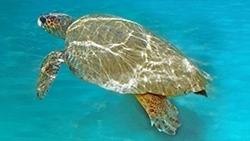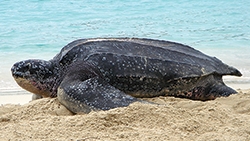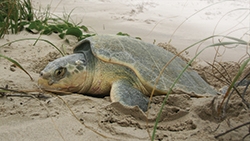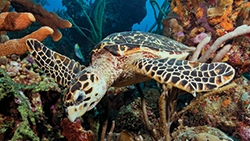Florida is home to thousands of sea turtles
Of the seven species of sea turtles worldwide, five can be found nesting in Florida: loggerhead, green, hawksbill, Kemp's ridley and leatherback.
Females nest on sandy beaches
Female sea turtles can travel hundreds or thousands of miles to nest. They lay their eggs on sandy beaches and will usually make several nests during one season. They may nest every two to three years. Nesting is a difficult process that can take up to three hours. A turtle must drag her great weight ashore, dig a nest with her back flippers, deposit about one hundred eggs, and cover and conceal the nest before returning to the sea. The eggs incubate in the warm sand and the female never visits her nest again.
How can you help?
- Never approach or harass sea turtles that are nesting or emerging from the sea
- Do not disturb or remove eggs from sea turtle nests
- Be careful while boating to avoid collisions with turtles
- Never throw trash in the water or on the beach
- Learn how to keep sea turtles in the dark
- If you find an injured or dead turtle in Florida, call the Florida Fish and Wildlife Conservation Commission's Wildlife Alert Hotline at (888) 404-FWCC or (888) 404-3922
- Purchase a "Helping Sea Turtles Survive" Florida license plate*

*Proceeds generated by sales of the turtle plate go to the Florida Fish and Wildlife Conservation Commission's Marine Turtle Protection Program to support research and management activities related to Florida's sea turtles. In addition, a portion of the revenue is distributed to Sea Turtle Conservancy, which then redistributes the funding through the competitive Sea Turtle Grant Program to support turtle projects in the areas of research, education and conservation that benefit Florida sea turtles.
Request Brochures
If your organization is interested in sharing this information, you can request printed copies of our sea turtle brochures. Visit our brochure order page to submit your request.




